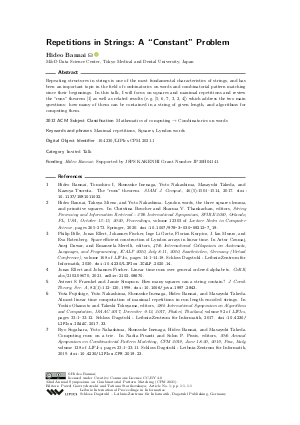Repetitions in Strings: A "Constant" Problem (Invited Talk)
Author
Hideo Bannai 
-
Part of:
Volume:
32nd Annual Symposium on Combinatorial Pattern Matching (CPM 2021)
Part of: Series: Leibniz International Proceedings in Informatics (LIPIcs)
Part of: Conference: Annual Symposium on Combinatorial Pattern Matching (CPM) - License:
 Creative Commons Attribution 4.0 International license
Creative Commons Attribution 4.0 International license
- Publication Date: 2021-06-30
File

PDF
LIPIcs.CPM.2021.1.pdf
- Filesize: 379 kB
- 1 pages
Document Identifiers
Subject Classification
ACM Subject Classification
- Mathematics of computing → Combinatorics on words
Keywords
- Maximal repetitions
- Squares
- Lyndon words
Metrics
- Access Statistics
-
Total Accesses (updated on a weekly basis)
0Document
0Metadata
Abstract
Repeating structures in strings is one of the most fundamental characteristics of strings, and has been an important topic in the field of combinatorics on words and combinatorial pattern matching since their beginnings. In this talk, I will focus on squares and maximal repetitions and review the "runs" theorem [Hideo Bannai et al., 2017] as well as related results (e.g. [Aviezri S. Fraenkel and Jamie Simpson, 1998; Yuta Fujishige et al., 2017; Ryo Sugahara et al., 2019; Philip Bille et al., 2020; Hideo Bannai et al., 2020; Jonas Ellert and Johannes Fischer, 2021]) which address the two main questions: how many of them can be contained in a string of given length, and algorithms for computing them.
Cite As Get BibTex
Hideo Bannai. Repetitions in Strings: A "Constant" Problem (Invited Talk). In 32nd Annual Symposium on Combinatorial Pattern Matching (CPM 2021). Leibniz International Proceedings in Informatics (LIPIcs), Volume 191, p. 1:1, Schloss Dagstuhl – Leibniz-Zentrum für Informatik (2021)
https://doi.org/10.4230/LIPIcs.CPM.2021.1
BibTex
@InProceedings{bannai:LIPIcs.CPM.2021.1,
author = {Bannai, Hideo},
title = {{Repetitions in Strings: A "Constant" Problem}},
booktitle = {32nd Annual Symposium on Combinatorial Pattern Matching (CPM 2021)},
pages = {1:1--1:1},
series = {Leibniz International Proceedings in Informatics (LIPIcs)},
ISBN = {978-3-95977-186-3},
ISSN = {1868-8969},
year = {2021},
volume = {191},
editor = {Gawrychowski, Pawe{\l} and Starikovskaya, Tatiana},
publisher = {Schloss Dagstuhl -- Leibniz-Zentrum f{\"u}r Informatik},
address = {Dagstuhl, Germany},
URL = {https://drops.dagstuhl.de/entities/document/10.4230/LIPIcs.CPM.2021.1},
URN = {urn:nbn:de:0030-drops-139523},
doi = {10.4230/LIPIcs.CPM.2021.1},
annote = {Keywords: Maximal repetitions, Squares, Lyndon words}
}
Author Details
Funding
- Bannai, Hideo: Supported by JSPS KAKENHI Grant Number JP20H04141.
References
- Hideo Bannai, Tomohiro I, Shunsuke Inenaga, Yuto Nakashima, Masayuki Takeda, and Kazuya Tsuruta. The "runs" theorem. SIAM J. Comput., 46(5):1501-1514, 2017. URL: https://doi.org/10.1137/15M1011032.
- Hideo Bannai, Takuya Mieno, and Yuto Nakashima. Lyndon words, the three squares lemma, and primitive squares. In Christina Boucher and Sharma V. Thankachan, editors, String Processing and Information Retrieval - 27th International Symposium, SPIRE 2020, Orlando, FL, USA, October 13-15, 2020, Proceedings, volume 12303 of Lecture Notes in Computer Science, pages 265-273. Springer, 2020. URL: https://doi.org/10.1007/978-3-030-59212-7_19.
- Philip Bille, Jonas Ellert, Johannes Fischer, Inge Li Gørtz, Florian Kurpicz, J. Ian Munro, and Eva Rotenberg. Space efficient construction of Lyndon arrays in linear time. In Artur Czumaj, Anuj Dawar, and Emanuela Merelli, editors, 47th International Colloquium on Automata, Languages, and Programming, ICALP 2020, July 8-11, 2020, Saarbrücken, Germany (Virtual Conference), volume 168 of LIPIcs, pages 14:1-14:18. Schloss Dagstuhl - Leibniz-Zentrum für Informatik, 2020. URL: https://doi.org/10.4230/LIPIcs.ICALP.2020.14.
- Jonas Ellert and Johannes Fischer. Linear time runs over general ordered alphabets. CoRR, abs/2102.08670, 2021. URL: http://arxiv.org/abs/2102.08670.
- Aviezri S. Fraenkel and Jamie Simpson. How many squares can a string contain? J. Comb. Theory, Ser. A, 82(1):112-120, 1998. URL: https://doi.org/10.1006/jcta.1997.2843.
- Yuta Fujishige, Yuto Nakashima, Shunsuke Inenaga, Hideo Bannai, and Masayuki Takeda. Almost linear time computation of maximal repetitions in run length encoded strings. In Yoshio Okamoto and Takeshi Tokuyama, editors, 28th International Symposium on Algorithms and Computation, ISAAC 2017, December 9-12, 2017, Phuket, Thailand, volume 92 of LIPIcs, pages 33:1-33:12. Schloss Dagstuhl - Leibniz-Zentrum für Informatik, 2017. URL: https://doi.org/10.4230/LIPIcs.ISAAC.2017.33.
- Ryo Sugahara, Yuto Nakashima, Shunsuke Inenaga, Hideo Bannai, and Masayuki Takeda. Computing runs on a trie. In Nadia Pisanti and Solon P. Pissis, editors, 30th Annual Symposium on Combinatorial Pattern Matching, CPM 2019, June 18-20, 2019, Pisa, Italy, volume 128 of LIPIcs, pages 23:1-23:11. Schloss Dagstuhl - Leibniz-Zentrum für Informatik, 2019. URL: https://doi.org/10.4230/LIPIcs.CPM.2019.23.
